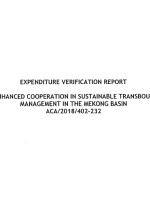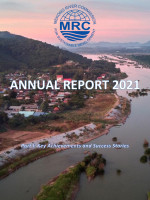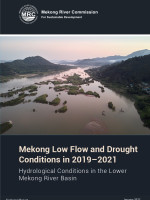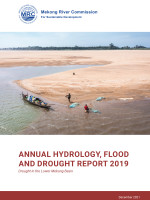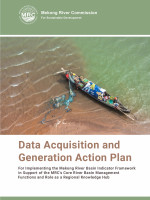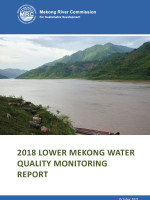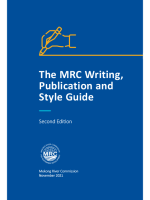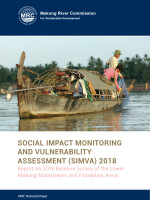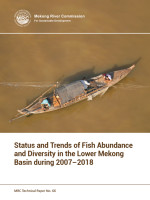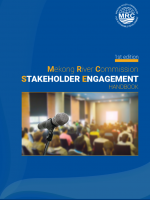Publications in English
Expenditure Report 2021 for EU Grant
Expenditure Verification Report, 31 December 2021
Download | DOI: 10.52107/mrc.aqypk2 | Published on: 18 May 2022 | Language: English
MRC Annual Report 2021 Part 1
Key Achievements and Success Stories
The Annual Report describes the success stories of the key achievements and progress of the Mekong River Commission during 2021 as the first year of implementation of the MRC Strategic Plan (MRC SP) 2021-2025, which is integrated with the Basin Development Strategy (BDS) 2021-2030. Despite having a difficult year in 2021 during the pandemic, some major preparatory work has been completed to pave the way for the implementation of the Strategic Plan 2021-2025. The five Strategic Priorities are identified to direct the realization of 11 BDS Outcomes and 30 Outputs by 2030. The MRC SP 2021-2025 is also based on these five strategic priorities or dimensions, namely Environment, Social, Economic, Climate Change, and Cooperation Dimensions. Each dimension reflects each SP with its equal importance to deliver BDS Outcomes and Outputs. A total of 95 routine and non-routine activities are deemed necessary to achieve these Outputs.
Download | DOI: 10.52107/mrc.b9hgs0 | Published on: 01 Mar 2022 | Language: English
Mekong Low Flow and Drought Conditions in 2019–2021
Conditions in 2019–2021: Hydrological Conditions in the Lower Mekong River Basin (Technical Report)
This technical report unravels the underlying drivers of the extremely low flows and drought based on an analysis of the available data the MRC has collected. Based on the findings, it suggests potential measures to address and mitigate the impacts of the hydrological droughts and storage on the Basin’s people.
Download | DOI: 10.52107/mrc.qx5yo7 | Published on: 13 Jan 2022 | Language: English
Annual Mekong Hydrology, Flood and Drought Report 2019: Drought in the Lower Mekong Basin
This paper reports on the condition of the Basin in 2019, including its hydrology/water flow, flood and drought. The year saw recorded unprecedented flow conditions in the Mekong mainstream and from tributaries. Erratic climatic fluctuations were also found, ranging from extreme dry to extreme wet within short periods of time. The report ends with key recommendations, looking forward.
Download | DOI: 10.52107/mrc.ajutoy | Published on: 27 Dec 2021 | Language: English
Data Acquisition and Generation Action Plan
This Data Acquisition and Generation Action Plan (DAGAP) has been developed to provide a clearer direction to the Member Countries and the MRC Secretariat on the data requirements necessary to implement the Mekong River Basin Indicator Framework (MRB-IF). It details the mechanisms that need to be put in place and systematically implemented to acquire and/or generate data to ensure the next State of the Basin Report will not have the same data gaps of previous reports.
Download | DOI: 10.52107/mrc.ajutp8 | Published on: 27 Dec 2021 | Language: English
2018 Lower Mekong Water Quality Monitoring Report
This reports on the results of the monitoring of water quality across 48 stations in the LMB. The report shows the water quality in the Mekong and Bassac Rivers was still of good quality with the slight improvement compared with 2016. There was only a small number of measurements of chemical oxygen demand (COD) and dissolved oxygen (DO) that violated the MRC Water Quality Guidelines for the Protection of Human Health (WQGH) and the MRC Water Quality Guidelines for the Protection of Aquatic Life (WQGA). Most exceedances were recorded in the Delta. Of a slight concern was the DO level at Chau Doc, which violated the WQGH for all sampling occasions causing water quality for the protection of human health to be downgraded from ‘good’ in 2017 to ‘moderate’ in 2018.
Download | DOI: 10.52107/mrc.qx5ynz | Published on: 19 Nov 2021 | Language: English
The MRC Writing, Publication and Style Guide
The MRC Writing, Publication and Style Guide contains guidance on common problems of English grammar, spelling, hyphenation, capitalization, document referencing, in-text citations, and bibliography organization. First published in 2007, this second edition of the Guide is intended for creators of MRC’s documents and publications, including MRC Secretariat’s staff members and consultants as well as external users who need a style guide.
Download | DOI: 10.52107/mrc.qx5yo4 | Published on: 12 Nov 2021 | Language: English
Social Impact Monitoring and Vulnerability Assessment (SIMVA) 2018
Report on 2018 baseline survey of the Lower Mekong mainstream and floodplain areas
SIMVA 2018 is the third survey of its type and was conducted in the same sites and used the same methods of collecting primary household and village data, as the SIMVA 2014 and 2011 exercises. Covering 2,800 households in 200 villages the 2018 survey shows that communities in the Mekong mainstream corridor were still dependent on the river resources for their livelihoods, income, and well-being. As such, they are still vulnerable to changes in the Mekong water resources. However, their overall dependency has decreased with other, non-water resources-related livelihood activities playing increasingly important roles. From 2014 to 2018 the percentage of households engaging in fishing decreased across the region from 50% to approximately 37%. The study also indicates growing incidence of flooding, possibly as a result of climate change and other factors, including water infrastructure development. Government support in livelihood diversification and disaster coping strategies is essential and there is much room for improvement in this regard.
Download | DOI: 10.52107/mrc.qx5ynt | Published on: 18 Oct 2021 | Language: English
Status and Trends of Fish Abundance and Diversity in the Lower Mekong Basin during 2007–2018
The report is the first ever large-scale study to consider both spatial and temporal variations of fish abundance and diversity in the LMB, using the MRC’s long-term fisheries monitoring data. The monitoring was conducted daily between 2007 and 2018 by professional fishers at 38 stations along the Mekong mainstream and its major tributaries. But only 25 sites were selected for the study due to incomplete data. Eleven of the 25 monitoring stations were in Cambodia, four in Lao PDR, and five each in Thailand and Viet Nam. The study found 617 fish species, belonging to 21 order and 80 families in the LMB from 2007 to 2018. Some 37,530,460 individuals, corresponding to 1,095,848 Kg of fishes were collected. Temporally, both fish diversity and catch have increased during the survey period in the Tonle Sap and the Mekong upstream in southern Laos and Thailand, informing the high diversity of these areas and that sampling effort is still growing.
Download | DOI: 10.52107/mrc.qx5yo0 | Published on: 18 Oct 2021 | Language: English
Mekong River Commission Stakeholder Engagement Handbook (1st ed.)
This handbook provides guidance on the principles and practice of stakeholder engagement within the MRC’s cooperation context. It spells out the different types of stakeholders, the engagement mechanisms and channels, and the related access and dissemination of information. It aims to contribute to increasing the understanding of the MRC’s principles and approaches in working with diverse stakeholders who have interests and concerns over the development and management of the Mekong River System.
Download | DOI: 10.52107/mrc.qx5yns | Published on: 28 Jul 2021 | Language: English
